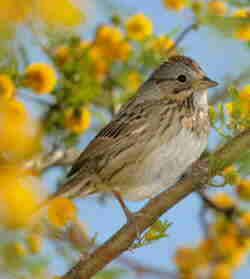 Lincoln's
Sparrow Lincoln's
SparrowMelospiza
lincolnii
Description
This little sparrow is most
easily identified by a streaked brown
back, gray breast, white throat, and
reddish-brown cap. Adults are 5-6 inches long and
weigh just under an ounce. Both sexes are similar
in coloration and size, and juveniles look like
small versions of adults.
Distribution and
Habitat
Lincoln's Sparrow breeds across
southern Canada and the extreme northern area of
the United States, south through the Rocky
Mountains; it winters from the southern United
States into Central America. From spring through
fall it is most commonly seen in bogs, wet
meadows, and riparian thickets. Its winter
habitat tends to be drier and ranges from brushy
or scrubby areas to open woodlands and forest
clearings.
Reproduction
Breeding pairs appear to be
monogamous during the breeding season, but it is
not known whether those pairs are formed for
life. The female builds a cup-shaped nest out of
dried grass either on the ground or in a low bush
or tussock. Three to six pale green, blue, pink
or white eggs spotted with brown are laid per
clutch, and both parents participate in
incubation until they hatch after 14 days. The
chicks are born naked and helpless but mature
rapidly and are able to leave the nest at about
20 days. Due to the relatively short maturation
period many pairs will breed twice in one season.
Diet
Lincoln's Sparrows feed primarily on spiders,
millipedes, and other small arthropods. They will
supplement their diet with seeds, berries, and
fruits when insects are less plentiful, and will
occasionally visit feeders. Birds tend to forage
on the ground alone or in very small numbers.
Scientific
Classification
phylum Chordata
subphylum Vertebrata
class Aves
order Passeriformes
family Fringillidae
genus & species Melospiza lincolnii
Questions or comments about
this page?
|



